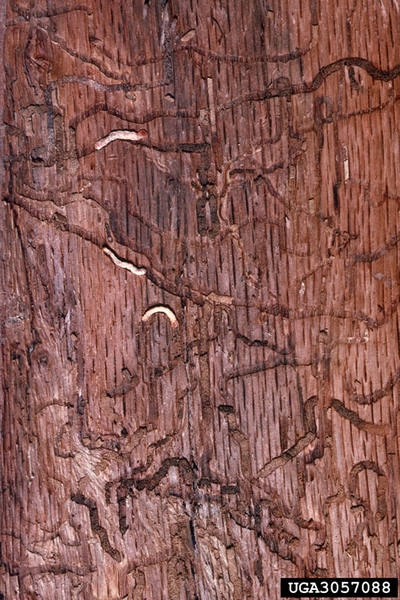Introduction
The twolined chestnut borer (Agrilus bilineatus) is a species of jewel beetle (family Buprestidae; also called metallic wood-boring beetles) that is native to eastern North America, including North Carolina (Figure 1). The larvae (immature stage) of this insect feed under the bark of a host tree, damaging the tree’s ability to transport water and nutrients (Figure 2). Twolined chestnut borer is in the same family as the emerald ash borer (Agrilus planipennis), an invasive forest pest that is not native to North Carolina.
Host Plants
Twolined chestnut borer primarily attacks oaks (Quercus spp.). This insect feeds on trees within both the red oak and white oak groups. Common oaks in North Carolina that are attacked by this insect include northern red oak (Q. rubra) and scarlet oak (Q. coccinea) in the red oak group and white oak (Q. alba) and chestnut oak (Q. montana) in the white oak group. As its name suggests, twolined chestnut borer was formerly an important pest of American chestnut (Castanea dentata) before this tree species was decimated by chestnut blight, a disease caused by the nonnative fungal pathogen Cryphonectria parasitica.
Identification
Twolined chestnut borer adults are small (0.2–0.5” long), metallic black beetles with a bluish iridescence (Figure 3). They have a pair of pale golden stripes running down their back (one stripe on each wing cover). Twolined chestnut borer larvae are cream-colored, segmented, and grow up to about 1” long. Larvae have a large, flattened head and a pair of spines at the tip of their last body segment (Figure 4). Larvae bore winding tunnels (called galleries) through the inner bark and outer wood of a tree (Figure 5). They typically have one generation per year, with larvae feeding in galleries during the growing season, overwintering in chambers they bore in the tree, and emerging as adults in the spring or early summer through D-shaped exit holes in the bark (Figure 6). While similar in shape and size to the related emerald ash borer, identification of the host plant is critical in separating these species based on exit hole alone: emerald ash borer only attacks ash (Fraxinus spp.) and white fringetree (Chionanthus virginicus).
Impacts
Oaks attacked by this insect display wilted, brown foliage in late summer followed by branch dieback (Figure 7). These symptoms typically begin near the top of the tree.
Unlike emerald ash borer, which attacks and kills healthy trees, twolined chestnut borer is considered a secondary pest, meaning it primarily attacks trees that are already stressed or damaged by other factors. Stress factors that may make trees susceptible to attack include water and nutrient deficiency and defoliation by other insect species that feed on leaves. Infestation by this insect is also closely tied with oak decline, a disease complex caused when multiple stress agents interact to weaken and eventually kill oak trees. Along with twolined chestnut borer, other agents commonly associated with oak decline include Armillaria root disease, drought, defoliation, late frost, soil compaction, and root and mechanical injury. No single stress agent plays a dominant role.
Management
Promoting tree health by reducing stress is the best way to prevent damage from twolined chestnut borer. Address water and nutrient deficiencies by watering, mulching, fertilizing, and planting oak species that are suited to growing in the soil and climate conditions of a site. Avoid wounding the trunk or roots of trees with landscaping equipment. Prevent excessive defoliation by managing foliage-feeding insects when needed, such as by installing sticky bands to manage cankerworms. By helping reduce stress, each of these practices can reduce a tree’s susceptibility to twolined chestnut borer and other potential pests. Consult the North Carolina Forest Service Forest Health Handbook or a certified arborist for tree care recommendations.
References
Blaedow, R., B. Heath, W. Langston, C. Lawing, J. Moan, R. Trickel, and K. Oten. 2013. Forest Health Handbook (3rd ed.). North Carolina Forest Service. pp. 114–115.
Haack, R. A., and R. E. Acciavatti. 1992. Twolined chestnut borer. Forest Insect & Disease Leaflet 168, USDA Forest Service.
North Carolina Forest Service. n.d. Oak decline.
Solomon, J. D. 1995. Guide to insect borers of North American broadleaf trees and shrubs. Agriculture Handbook 706, USDA Forest Service. pp. 214–217.
USDA Forest Service. 1997. Insects and diseases of trees in the South. Protection Report R8-PR 16, USDA Forest Service, Southern Region. p. 30.
USDA Forest Service. 2011. Twolined chestnut borer. USDA Forest Service, Rocky Mountain Region, Forest Health Protection.
Publication date: Aug. 3, 2022
N.C. Cooperative Extension prohibits discrimination and harassment regardless of age, color, disability, family and marital status, gender identity, national origin, political beliefs, race, religion, sex (including pregnancy), sexual orientation and veteran status.







